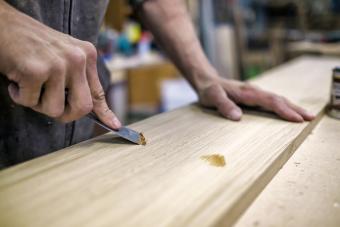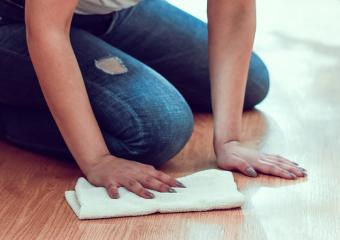
Dropping glue on your hardwood floor or getting a drop of superglue on your antique wood chair might spell disaster. Thankfully, there are home cleaning remedies and commercial cleaners that can get adhesive off of hardwood floors and wood. Explore how glue removal methods might be different for raw and finished wood.
Removing Glue From Raw Wood
When it comes to removing glue from raw wood, you have to be careful of what you use because oils that you might use on finished wood can be absorbed by the raw wood. Therefore, your methods are going to be a bit different. For your glue removal, you'll need:
- Razor blade or putty knife
- Fingernail polish remover or acetone
- Clean towel
- Sanding paper (grit will depend on the roughness of the wood)
- Blow dryer
- Cotton ball
Scrape the Glue
This method works for removing dried glue drips, fabric glue, and even stickers from raw wood. This might be a panel that your child put a sticker on or even extra glue from a woodworking arts and craft project.

- Using the putty knife or razor blade gently get underneath of the glue.
- Rocking the blade or knife under the glue try to slowly peel it up. Once you get it started, you should be able to grab and peel the glob or sticker off the wood.
- Plug in and turn on the hair dryer, using the heat setting, slowly heat up the area.
- Use a warm rag to rub the softened glue off the wood.
Try Acetone
Sometimes after you get the glob off, you still have a bit of adhesive left over. In this case, you will bust out the acetone to break down the adhesive to remove it.
- Wet a towel or cotton ball with acetone or fingernail polish remover.
- Rub it over the adhesive.
- For stubborn adhesive, let it sit on the area for up to 15 minutes. (Make sure to keep the area wet since acetone evaporates quickly.)
- Use a clean towel to vigorously rub the area removing any stubborn residue.
- Repeat as necessary.
Sanding It Down
If scrapping and acetone aren't working, it might be time to break out the big guns. Sand paper comes in different grits. Course grit is under 100 while fine grit runs in the 300+ range. Depending on the roughness of your raw wood, you are going to need different grits of sandpaper to remove the adhesive. Super fine grit might not be enough for rough sawn-wood, while planed wood would need fine sandpaper to avoid scratching the wood. If you are unsure, there are sandpaper guides online.
- Choose your sandpaper.
- Fold the sandpaper in half.
- Gently sand the area until the adhesive is gone.
- Check your work periodically to avoid over-sanding the area.

Removing Glue From Stained Wood
Wood with stained finishes can be easier to get glue like fabric glue or Elmer's glue off, but you have to be careful of scratching the finish wood on flooring or furniture. For stained wood, you'll need:
- Heat gun or hair dry
- Clean towel
- White vinegar
- Dish soap
- Mineral oil
- Mask

Vinegar for Wet Glue
For glue that is still wet, you can use a more natural method for removal. Simply follow these steps:
- Wipe up as much of the wet glue as possible.
- Mix 1 cup warm water, ½ cup vinegar, and a drop or two of dish soap.
- Wet a towel and gently rub the adhesive. The friction will also create heat to warm the glue up making it come off a bit easier.
- For particularly tough areas, let the mixture sit on it for about 10-15 minutes before scrubbing.
Mineral Oil for Dry Glue
Dry glue is a bit more of a challenge when it comes to your stained hardwood floors. This is particularly true for dried superglue.
- Using the heat gun or hair dry heat up the glue.(Do this in a well-ventilated area or wear a mask, particularly with super glue because it can cause fumes when it gets too hot.
- Take a wet towel and put it in the microwave for 15-30 seconds.
- Carefully take it out with tongs or a potholder. It will be hot.
- Apply it to the glue for about 30 seconds.
- Use the towel or fingers to try to peel the softened glue up.
- Apply a small amount of mineral oil to the remaining adhesive.
- Scrub at the glue with a clean cloth.
If the glue or residue still remains, you might need to sand and refinish the area. However, you might want to call your flooring installer or a flooring specialist first.

How to Remove Adhesives From Wood
Are you trying to remove sticker residue? Removing adhesive from wood doesn't require much more than a little alcohol and a clean towel. FYI, alcohol also removes tape residue.
- Soak a section of the towel in the rubbing alcohol (vodka can also make a good alternative).
- Rub the adhesive until it peels away.
- Wet the towel and wipe the area.
If you don't have rubbing alcohol, you can try using acetone or fingernail polish remover.
Commercial Cleaners for Removing Glue on Wood
If nothing is working to remove the glue or adhesive, you can try using commercial cleaners for glue. These cleaners are designed to break down glue so that you can remove it from your floor or wood furniture. A few cleaners you might try include:
- Goo Gone - This commercial cleaner works well for removing adhesive from doors and floors. You can also try it on your wood furniture, just make sure to follow the instructions.
- Goof Off - This is an industrial adhesive cleaner for removing adhesives and glue. According to the manufacturer, it can be used on finished wood in a well-ventilated area, but you will want to try it on a small area first.
Precautions to Consider
When it comes to getting glue off your wood, you need to be careful. You should always test a treatment on an area first to ensure it won't stain your wood or hurt your finish. If in doubt, call a professional floor cleaner.
The Sticky on Removing Glue From Wood
Glue can be a big problem, especially if it splashed on your antique wood chair or gets on your rough-cut wall. When it comes to getting glue off, you'll need to use the best method for your finish. Now that you have been schooled in glue cleanup, get some tips on how to clean sticky wooden kitchen cabinets.







